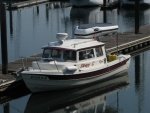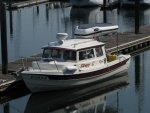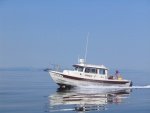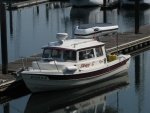Today we went 2 miles out and 7 miles south from Newport, Oregon. At the end of our trip we re-fueled at the fuel dock in the Newport Marina. The guy who runs the fuel dock (a retired Commercial Shrimp and Tuna boat Captain) complimented us about C-Dory boats. He said, "C-Dory boats are good solid boats and are very safe." I thanked him for this compliment knowing that it was made with honesty and especially coming from someone with his experience.
While we were out today the ocean conditions were more severe that what NOAA had predicted. While returning and wanting to cross the bar at 3pm, we met up with a Coast Guard Ship checking on the ocean conditions. Listening to VHF, we heard the upgraded ocean conditions and were glad to hear that the bar was still open for us to get back to Newport. We followed the big ship across the bar in his wake which made for easy travel. Good timing for us to be there while they were in the area! Wind waves were bigger than originally predicted, up to 4', and more than we wanted for our 2nd trip over the bar! Swells were 5' and off the beam at the entrance, so it was a rough ride. It was really cool to watch the C-Dory handle the ocean as we cut through the water/spray. We felt totally safe in our C-Dory knowing that it was a solid boat.
While we were out today the ocean conditions were more severe that what NOAA had predicted. While returning and wanting to cross the bar at 3pm, we met up with a Coast Guard Ship checking on the ocean conditions. Listening to VHF, we heard the upgraded ocean conditions and were glad to hear that the bar was still open for us to get back to Newport. We followed the big ship across the bar in his wake which made for easy travel. Good timing for us to be there while they were in the area! Wind waves were bigger than originally predicted, up to 4', and more than we wanted for our 2nd trip over the bar! Swells were 5' and off the beam at the entrance, so it was a rough ride. It was really cool to watch the C-Dory handle the ocean as we cut through the water/spray. We felt totally safe in our C-Dory knowing that it was a solid boat.





